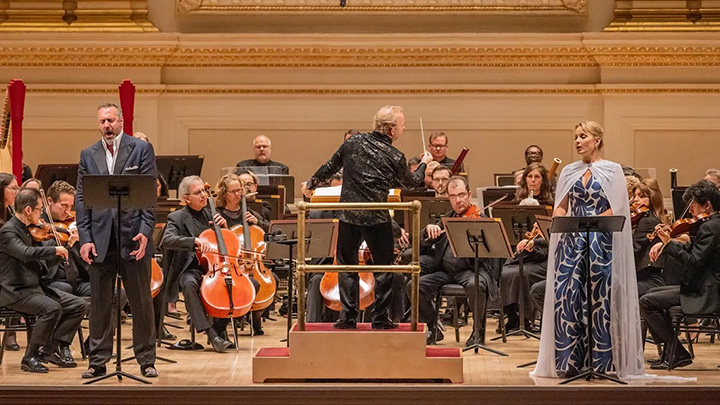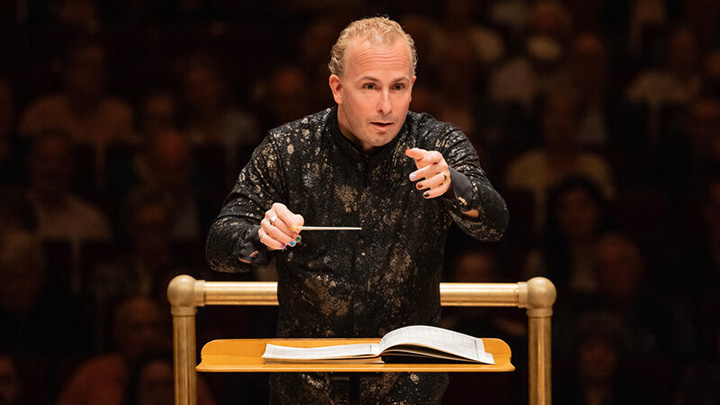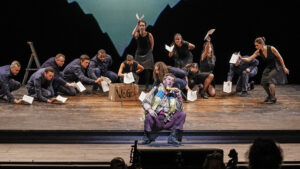There was his debut in 2009: a swift, propulsive, and stylishly Gallic Carmen. Then there was that Don Carlos where he drew out the most gorgeous, dark sound from the brass; a Rusalkawith an ominous symphonic sweep. But since taking over as the Met’s music director in 2018, critical and public enthusiasm has distinctly waned. Is it simply out of boredom, now that he’s here to stay? Is it the fact that he’s overbooked and overscheduled, running the Met alongside two other orchestras? Or has he not matured enough as a conductor, not living up to his early promise? A pair of concerts featuring the Met Orchestra at Carnegie Hall provided no easy answers.
The second of these concerts was the more overtly operatic: Wagner’s Flying Dutchman overture, Erich Leinsdorf’s arrangement of the orchestral interludes from Debussy’s Pelléas et Mélisande, and Bartók’s Bluebeard’s Castle with Met stalwarts Christian van Horn and Elina Garanca. But for better or for worse, Nézet-Séguin presented it as a showcase for the orchestra, starting from a Wagner so rambunctious it threatened to overwhelm the usually reliable brass section. Extreme tempos and dynamic shifts made for a thrilling experience, but lacked the orchestra’s usual precision and polish.
On the other hand, Pelléas made a strong case for why Nézet-Séguin is indeed one of the great conductors of his generation. Leinsdorf’s suite draws mainly upon Debussy’s orchestral interludes, some of the most evocative, mysterious music in the opera. It’s a nebulous work, rarely rising above a whisper, but Nézet-Séguin brought a wealth of color and texture. I’ve often found him overly focused on effects at the expense of line, but in the Debussy he achieved an ideal synthesis of forward momentum interspersed with moments suspended in time.
Bluebeard showed off Nézet-Séguin at his best and his worst. He favors a big, old-school sound – his directorship at the Philadelphia Orchestra has clearly developed his preference for the voluptuous sound world of Stokowski and Ormandy. This approach works for much of Bartók’s score, with marvelous attention to orchestral color and a spectacular buildup to the rip-roaring C major chords of the 5th door. But for me, the genius of Bartók’s score comes in the last half of the opera – the eerie harp glissandi of the 6th door, the ghostly unison strings at the very end. Here, Nézet-Séguin seemed content to focus on the orchestral effects themselves rather than the atmosphere. It had the effect of a brightly-lit haunted house.
That’s a wrap on the @MetOrchestra’s fabulous concerts series at Carnegie Hall! Now they’re off to Korea to kick off their first-ever Asia tour, led by Met Music Director @NezetSeguin. As we wish them safe travels, enjoy this excerpt from Bartók’s Bluebeard’s Castle pic.twitter.com/fvwKPIs9jO
— Metropolitan Opera (@MetOpera) June 17, 2024
There was no doubting, though, the quality of the singing. Christian van Horn has established himself as one of the Met’s most reliable singers, and Bluebeard establishes him as a viable leading man. His bass has an old-school, Tozzi-like velvety elegance, and it’s a sound that projects effortlessly even when Nézet-Séguin has the orchestra at full force. It’s not the most probing of interpretations, but he declaims the text effectively and is a sufficiently charismatic presence to understand why Judith would give it all up for him.
But the main draw of the evening was Garanca, who premiered her Judith just last month in Naples. Impeccably coiffed and dressed in a navy and white gown reminiscent of Matisse’s cutouts, she offered a mature, knowing take on the character. It was very much Judith by way of Kundry, another one of Garanca’s recent successes as her mezzo grows in size and color. Judith is still a work in progress for her – the first part of the role sits a little low for her and she sounds hollow at times, as if trying to pump the sound out. But it remains a gorgeously creamy sound, all the way up to a ringing, sustained high C that most sopranos would envy. Overall, it was a performance for the recording studios: glamorous, plush in sound, big on effects. But whether that translates into something more profound remains to be seen.
Photos: Evan Zimmerman/Metropolitan Opera








Comments